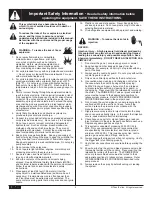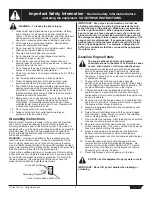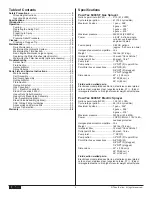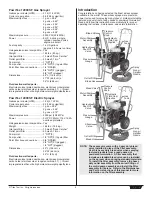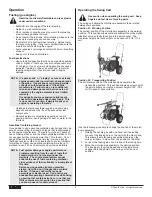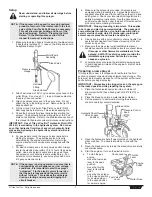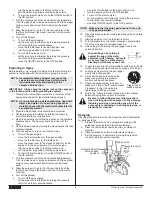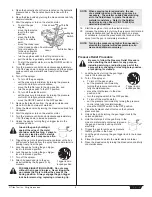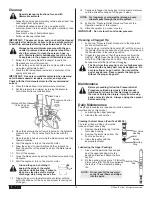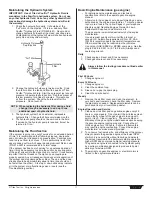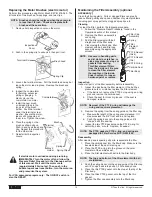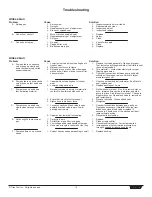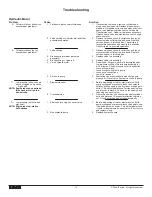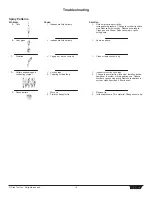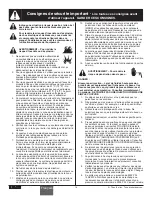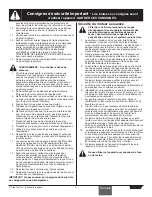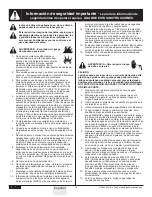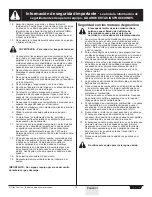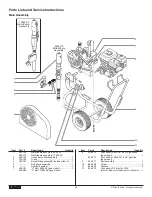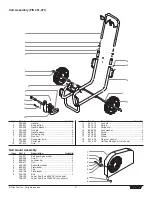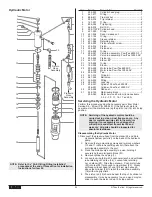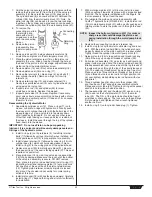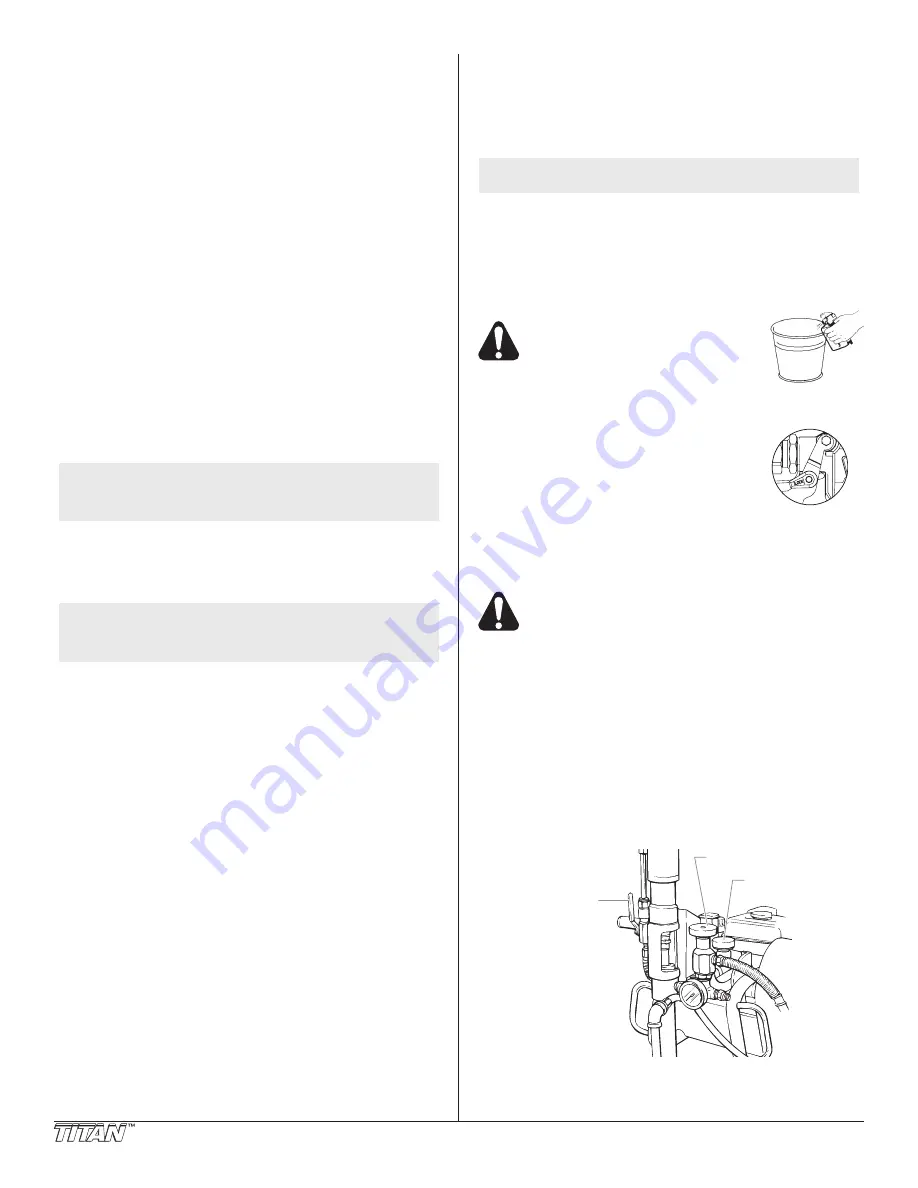
8
© Titan Tool Inc. All rights reserved.
• turn the engine switch to the ON position, and
• pull the starter rope briskly until the engine starts.
b. To start the electric motor, move the ON/OFF switch to
the ON position.
7. Turn the pressure control knob clockwise approximately
1/3 of the way down to increase pressure until the sprayer
cycles evenly and solvent flows freely from the bleed
hose.
8. Allow the sprayer to run for 15–30 seconds to flush the
test fluid out through the bleed hose and into the waste
container.
9. Turn off the sprayer.
a. To turn off the gas engine,
• set the pressure to minimum by turning the pressure
control knob fully counterclockwise,
• move the throttle lever to the slow position, and
• turn the engine switch to the OFF position.
b. To turn off the electric motor,
• set the pressure to minimum by turning the pressure
control knob fully counterclockwise,
• move the ON/OFF switch to the OFF position.
Preparing to Spray
Before painting, it is important to make sure that the fluid in the
system is compatible with the paint that is going to be used.
NOTE: Incompatible fluids and paint may cause the
valves to become stuck closed, which would
require disassembly and cleaning of the
sprayer’s fluid section.
IMPORTaNT: always keep the trigger lock on the spray gun
in the locked position while preparing the system.
1. Place the foot valve/shovel valve into a container of the
appropriate solvent for the material being sprayed.
NOTE: If you are spraying a water-based latex, flush with
warm, clean water. If you are using any other
material, check with the material manufacturer for
a compatible solvent.
2. Place the bleed hose into a metal waste container.
3. Set the pressure to minimum by turning the pressure
control knob fully counterclockwise.
4. Open the hydraulic shut-off valve located on the hydraulic
pressure hose. The handle should be in line with the
hose.
5. Open the bleed valve by turning the bleed valve knob fully
counterclockwise.
6. Start the engine or turn on the electric motor.
a. To start the gas engine,
• move the fuel valve lever to the open position,
• move the throttle lever to its middle point,
• move the choke lever to the closed position for a cold
engine or to the open position for a warm engine,
• turn the engine switch to the ON position, and
• pull the starter rope briskly until the engine starts.
b. To start the electric motor, move the ON/OFF switch to
the ON position.
7. Turn the pressure control knob clockwise approximately
1/3 of the way down to increase pressure until the sprayer
cycles evenly and solvent flows freely from the bleed
hose.
8. Allow the sprayer to run for 15–30 seconds to flush the
test fluid out through the bleed hose and into the waste
container.
9. Turn off the sprayer.
a. To turn off the gas engine,
• set the pressure to minimum by turning the pressure
control knob fully counterclockwise,
• move the throttle lever to the slow position, and
• turn the engine switch to the OFF position.
b. To turn off the electric motor,
• set the pressure to minimum by turning the pressure
control knob fully counterclockwise,
• move the ON/OFF switch to the OFF position.
NOTE: Make sure that the spray gun does not have a tip
or tip guard installed.
10. Close the bleed valve by turning the bleed valve knob fully
clockwise.
11. Start the engine or turn on the electric motor.
12. Turn the pressure control knob clockwise approximately
1/3 of the way down to increase pressure.
13. Unlock the gun by turning the gun trigger lock to the
unlocked position.
Ground the gun by holding it
against the edge of the metal
container while flushing. Failure to
do so may lead to a static electric
discharge, which may cause a fire.
14. Trigger the gun into the metal waste container until the old
solvent is gone and fresh solvent is coming out of the gun.
Trigger lock in
locked position.
15. Lock the gun by turning the gun trigger
lock to the locked position.
16. Set down the gun and increase the
pressure by turning the pressure
control knob slowly clockwise.
17. Check the entire system for leaks. If
leaks occur, follow the “Pressure Relief
Procedure” in this manual before
tightening any fittings or hoses.
18. Follow the “Pressure Relief Procedure” in this manual
before changing from solvent to material.
Be sure to follow the pressure relief procedure
when shutting down the sprayer for any purpose,
including servicing or adjusting any part of the
spray system, changing or cleaning spray tips, or
preparing for cleanup.
Spraying
Use this procedure to start up the PowrLiner and PowrHandler
for daily operation.
1. Prepare the material to be sprayed according to the
guidelines given by the material manufacturer.
2. Place the foot valve/shovel valve into a container of
material.
3. Place the bleed hose into a metal waste container.
4. Set the pressure to minimum by turning the pressure
control knob fully counterclockwise.
Hydraulic Shut-off
Valve (in open
position)
Pressure Control
Knob
Bleed Valve


